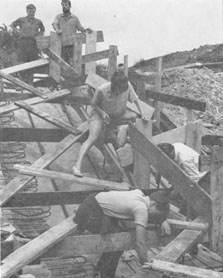
 |
Back to start |
Visits paid to a number of these quickly made it clear that many school pools were not being built in accordance with modern safety standards, in terms of the depth of water required for diving. The minimum depths laid down in the safety standard approved by the Amateur Swimming Association are 11 ft. 4½ in. for a 3 metre springboard and 12 ft. 5½ in. for a 5 metre springboard, which we intended to install. The result was a design for a pool actually two and a half times the volume of the Hatfield pool; it would be short sighted for us to aim at anything smaller, and unthinkable to build a pool below the most recent safety standards. The School's swimming pool was clearly going to be a much better one than had originally been planned; it was equally clearly going to be a great deal more expensive. The £3,000 had become £5,700.
Naturally, as time went on funds came in more slowly; but by November 1963, two years after the launching of the project, only another £1,000 needed to be found. A second Fair during the Summer term 1964 provided the last "heave" (these two efforts raised respectively £985 and £730, each in the course of a single afternoon) and the whole cost of the pool had been raised in just over two and a half years.
It would be impossible to list all the money-raising methods that were employed both inside and outside the School; they included coffee mornings, cake stalls in a local market, biscuit selling in "break" time at School, carol singing, staff-and-parent dances, crabapple jelly making, jumble sales, a Madeira morning, film shows, concerts, a barbecue, a book sale, shoe cleaning, wood chopping, clothes washing, the making of Christmas cards, lampshades, toffee, pyjama cases, toffee-apples, toys, as well as jobs of all kinds done by children during their holidays. One senior boy spent the whole of Christmas working as a kitchen hand in a Butlin's Holiday Camp; another found that it was one thing to collect five hundred "empties" from social gatherings, but quite another to dispose of them, since licensed houses would only accept a handful at a time. These were only two examples of the resourcefulness that was shown by dozens of children in raising their quota for the swimming pool fund.

|
Stephen Harris and Michael Pooley direct operations. |
| Back to previous. | Continue to next page. |
| Back to start | |